Contents
- Features to Consider in Good Knee Braces for Sports
- Top 10 Best Knee Braces for Sports 2024
- 1. Best Overall Pick: UFlex Athletics Knee Compression Sleeve
- 2. Best Budget Option: CAMBIVO 2 Pack Knee Brace
- 3. Best for Comfort: Physix Gear Knee Support Brace
- 4. Best for Serious ACL Injuries: Shock Doctor Maximum Support Compression Knee Brace
- 5. Best for Stability: EXOUS Knee Brace Support Protector
- 6. Best Hybrid: Athledict Knee Brace Compression Sleeve
- 7. Best Comfort Option for the Meniscus: TechWare Pro Knee Compression Sleeve
- 8. Best Support Option for the Meniscus: Bodyprox Knee Brace With Side Stabilizers
- 9. Best for General ACL Injuries: TechWare Pro Knee Brace
- 10. Best Budget for Late-Stage Recovery: Solimo Elastic Knee Stabilizer
- Guide to Buying the Best Knee Braces for Sports
- Final Thoughts
Features to Consider in Good Knee Braces for Sports
Athletes at any level, whether professional or casual, are susceptible to injuries. Knee injuries are among the most common, and the most feared, due to their potential to lead to a long and painful recovery period.
A knee brace can not only reduce nagging pains and speed up the healing process after an injury, but a well-designed brace can go a long way towards allowing an injured person to have relatively few restrictions on their movement. On top of that, a properly chosen knee brace can even reduce the risk of injury in the first place. If you play sports at any level, or even if you lift heavy objects frequently enough to worry about your knees, you should consider purchasing a knee brace.
The market for knee braces is surprisingly crowded, and many of the options might seem nearly identical at first glance to the untrained eye. By keeping in mind just a few characteristics, you can make sure that you end up purchasing a high-quality product that meets your needs.
What Problem Does the Knee Brace Solve?
Essentially, knee braces can be used for two purposes: injury prevention and injury rehabilitation. While some braces can effectively do both, different design choices often result in a knee brace better suited to one purpose or the other. On the whole, there are three major categories that knee braces fall into: those most well suited for general injury rehabilitation and prevention, those designed to protect the meniscus of the knee (the shock-absorbing cartilage inside the knee cap), and braces that protect the anterior cruciate ligament (ACL) that allows the knee to flex and bend.
What Benefits Does the Brace Provide?
After ensuring that you’re buying a brace that will fit your intended purpose, the next important consideration is determining what style of brace best achieves that goal. There is a surprising amount of technology and clever design in today’s knee braces. As such, there are a huge number of products and wide variations in the comfort, protectiveness, and range of motion allowed by each brace.
Who Is the Knee Brace Designed For?
All knee braces are not created with the same customer in mind. Just as each brace is designed to solve or alleviate a specific medical issue, and just as each brace has different features, each brace is specifically suited to a specific type of person. Some are made for professional athletes, others for weekend warriors, and others still for less active individuals like office workers and the elderly.
Top 10 Best Knee Braces for Sports 2024
1. Best Overall Pick: UFlex Athletics Knee Compression Sleeve
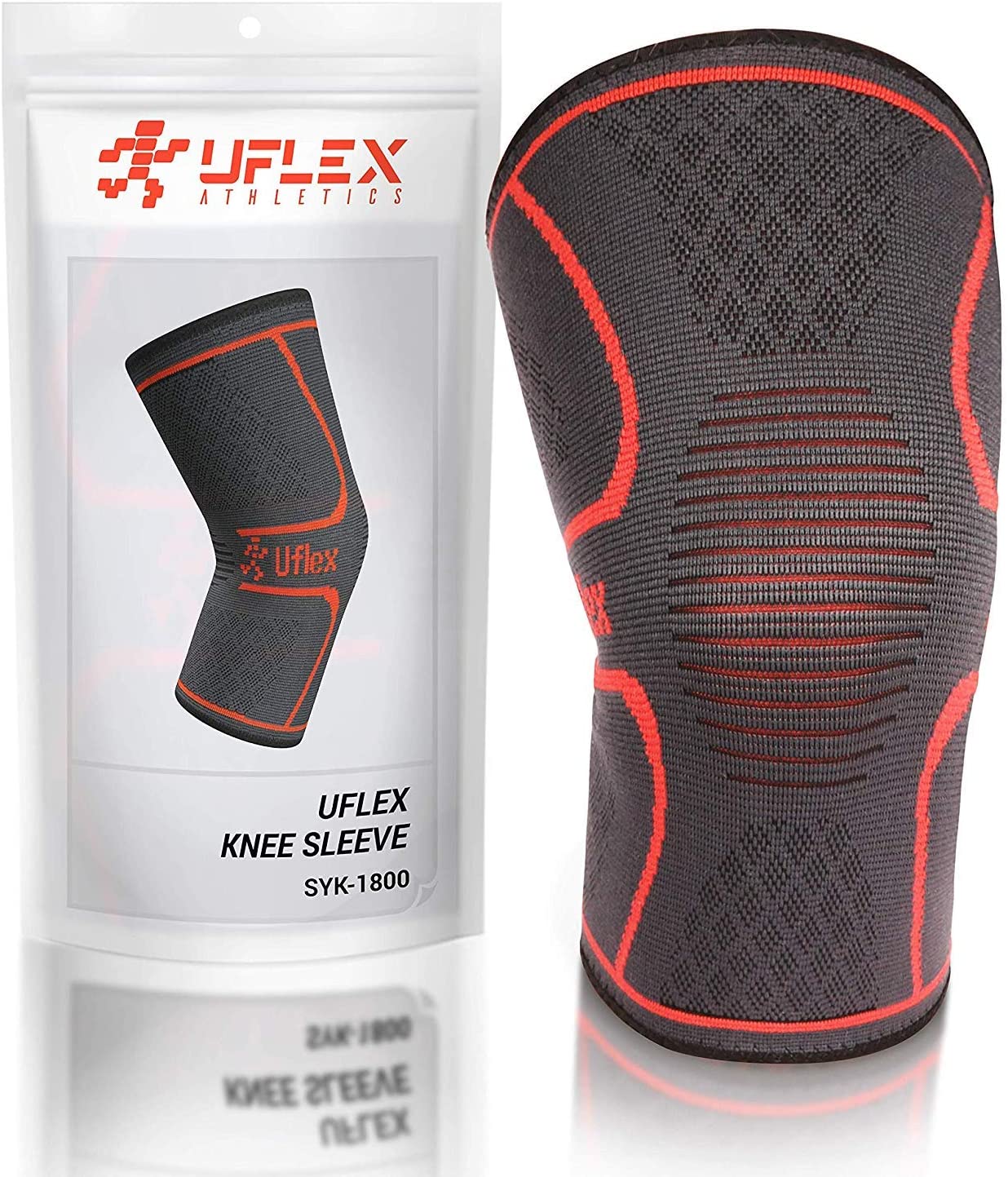
Editor’s Rating:
Design
The UFlex Athletics Knee Compression Sleeve is a sleeve-style knee brace with an impressive combination of features that should meet the needs of most shoppers. Many sleeve braces are little more than a compressing piece of fabric that won’t do much more than apply pressure to the knee, but that isn’t the case here. Though not fancy or complicated, a lot of thought has gone into this product’s design and choice of materials.
Effectiveness
Its knit construction not only creates even compression from every angle, but also ensures a tight yet not uncomfortable fit. The UFlex’s silicone wave grip keeps the sleeve in place, while its three layers of fabric do an excellent job of keeping the knee stabilized while not restricting your range of motion. It’s a simple concept, but it’s executed perfectly—the UFlex Athletics Knee Compression Sleeve just works.
Who Should Buy This Brace?
Unless you’re in the early stages of a serious injury that necessitates the added stability offered by a brace with external supports or heavy-duty straps, you can’t go wrong with this UFlex sleeve. It might look almost too basic to be effective at first glance, but it gets the job done—without stretching your budget.
- Perfect combination of comfort and protection
- Silicone grip gel keeps the sleeve in place
- Stretchable construction allows for a full range of motion
- Some customers say it’s a bit too tight—so make sure you choose the correct size
2. Best Budget Option: CAMBIVO 2 Pack Knee Brace
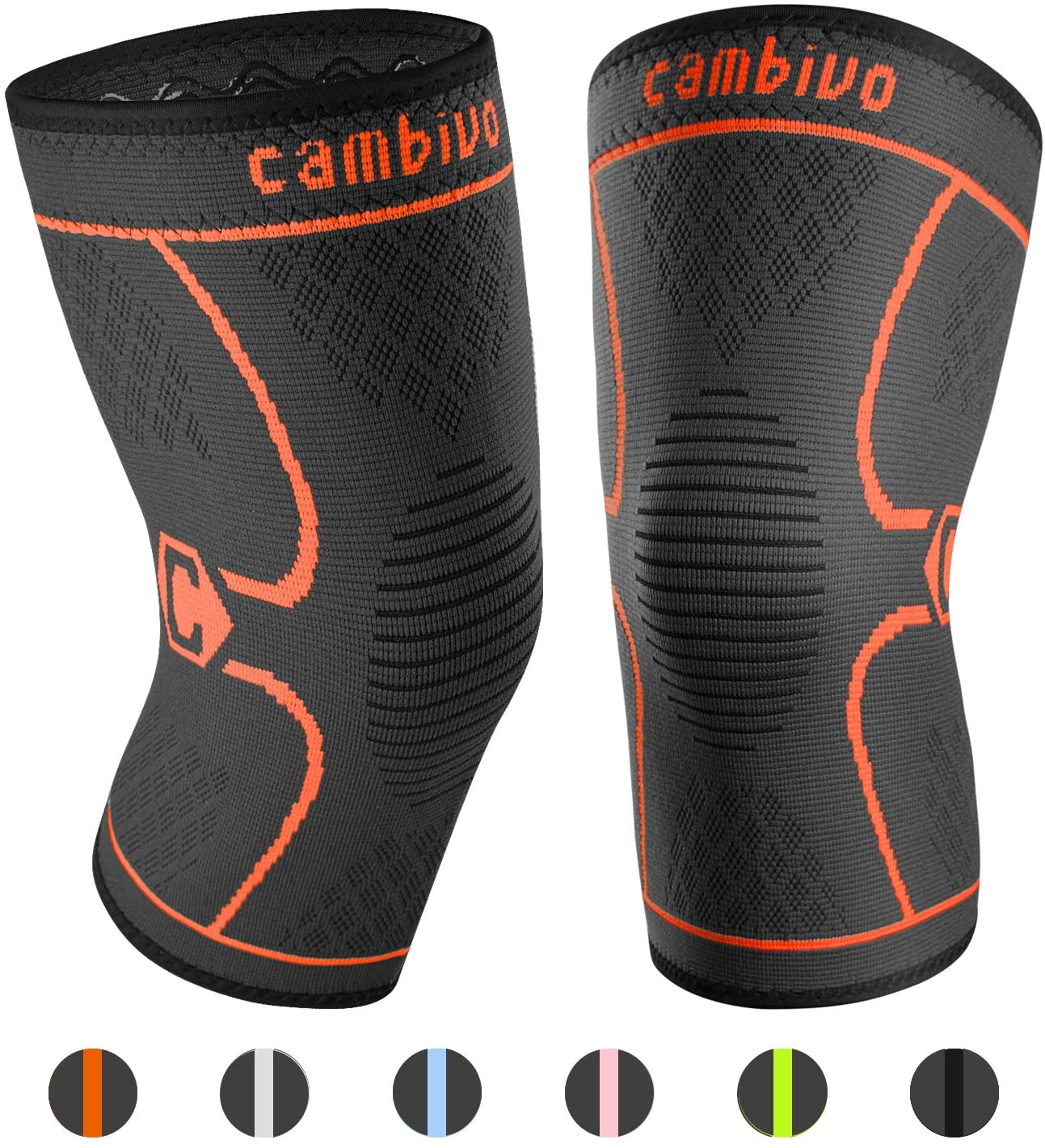
Editor’s Rating:
Design
The CAMBIVO 2 Pack Knee Brace follows the same design principles as most sleeve braces, combining a compressive knit fabric with silicone gel to keep the brace and your knees in place. It is a little bit thicker than some of its competitions, but not so bulky that it won’t fit cleanly under pants or shorts. It’s also large enough to adequately cover any of the knee’s problem areas, and comes in a market-leading thirteen different color options.
Effectiveness
Though the CAMBIVO brace might seem like it would be a market-leading knee brace on paper, it doesn’t match up to the UFlex or Physix in its execution. It won’t protect as well as the UFlex, and it won’t feel quite as nice as the Physix. That being said, it’s no slouch—it might not be up to the standards of the best of the best, but it’s much better than your average knee brace.
Who Should Buy This Brace?
The CAMBIVO Knee Brace is not at all suited to recovery from the early stages of a serious knee injury, or even a moderate one. But that does not mean that it’s useless. It’s not at the top of its class in any areas, but it’s not substandard anywhere, either. Where the CAMBIVO 2 Pack Knee Brace really stands out is its price: for the money, it’s one of the best braces for late-stage injury rehabilitation or injury prevention.
- Full-featured, just not quite as well-executed as some of its competition
- A solid all-around knee brace that meets standards in every area
- Thirteen color options
- If you need two braces, this is as cheap as it gets
- Not protective enough to be considered for recovery or rehabilitation from serious injuries
3. Best for Comfort: Physix Gear Knee Support Brace
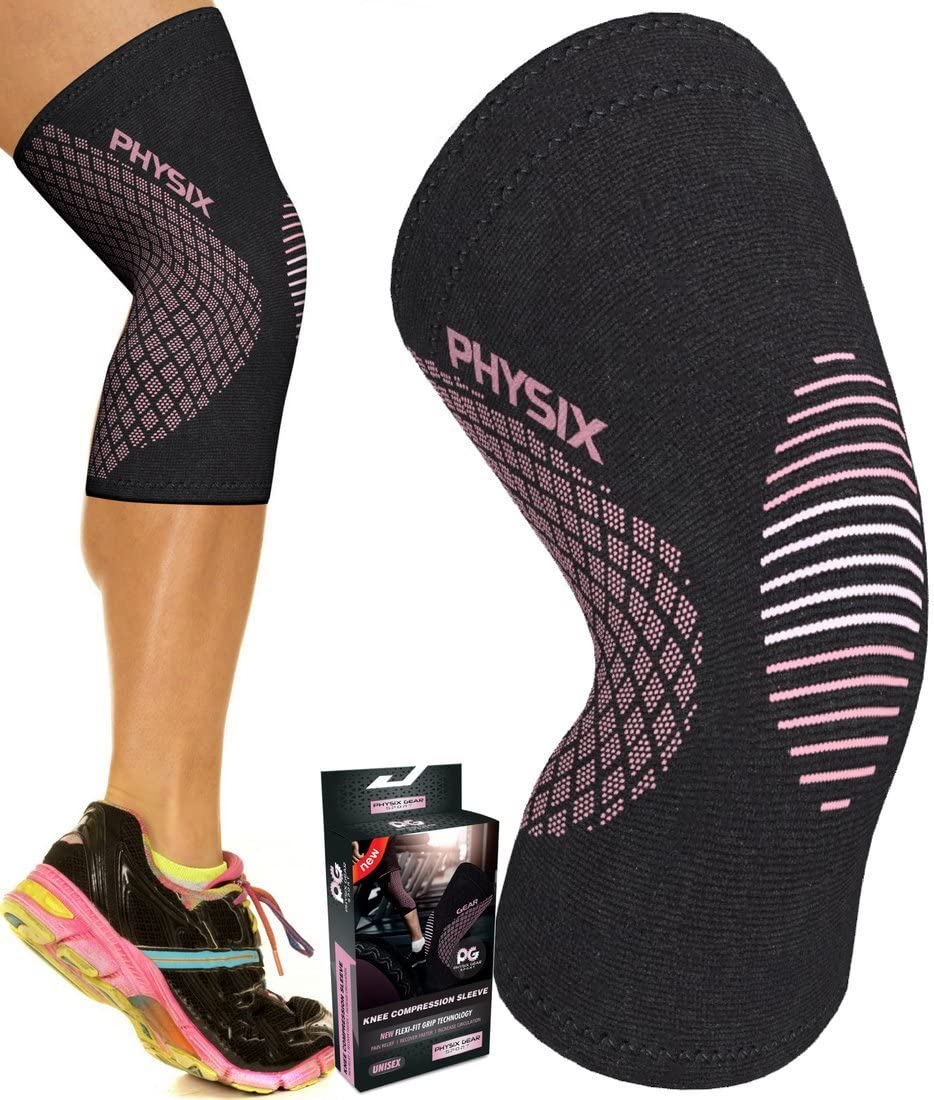
Editor’s Rating:
Design
This sleeve follows a similar design philosophy as the UFlex, but differs in a few key areas. Though it might appear similar, the Physix concentrates on comfort and range of motion a bit more than most of its competition. That being said, its impressive coverage and graduated compression do effectively brace the knee, while not sacrificing the product’s comfort and breathability. Unlike many knee braces, the Physix Gear Knee Support brace not only comes in a number of different sizes, but a few different color options, too.
Effectiveness
As a lightweight knee brace, the Physix isn’t quite as protective as many of the competitors, but it’s no slouch. The product uses a mixture of Lycra and nylon to ensure that it properly supports the knee while still allowing it to move. On top of that, the stretchy machine-washable fabric is more comfortable and easier to put on and remove than most of the competition.
Who Should Buy This Brace?
The sleeve brace designed by Physix is probably the thinnest, most fashionable, and most comfortable knee brace for sports on the market today. Some concessions were made with protectiveness to achieve these strengths, but that’s not to say that it’s not an effective brace in the right circumstances. For general prevention or during the later stages of recovery, the Physix Gear Knee Sleeve is a clear frontrunner.
- Unparalleled comfort with its feature set
- Large size ensures total coverage of the injured area
- Graduated compression protects the more vulnerable areas of the knee
- Comes in your choice of size and color
- Not quite as protective as some of its alternatives
4. Best for Serious ACL Injuries: Shock Doctor Maximum Support Compression Knee Brace
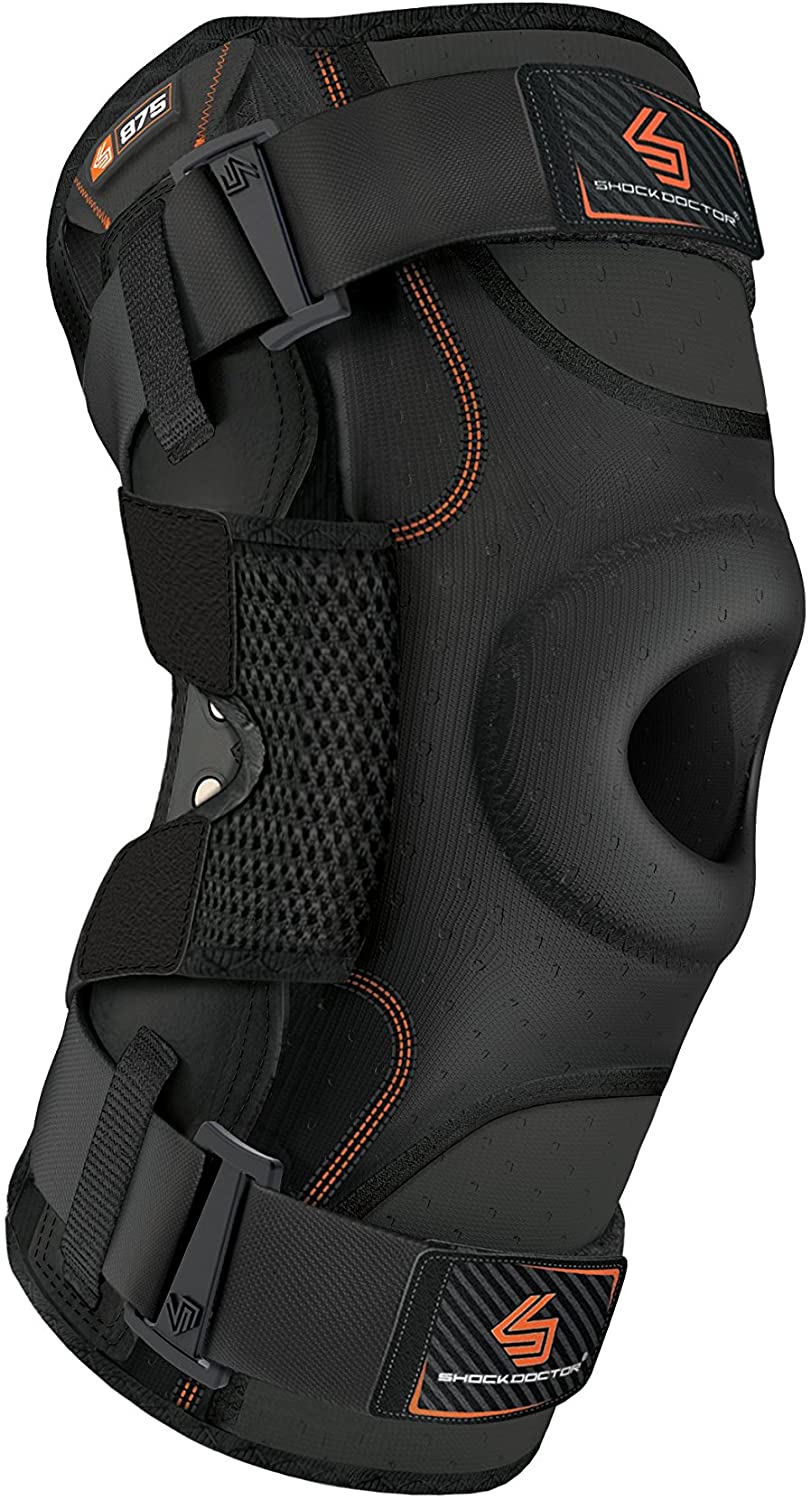
Editor’s Rating:
Design
The Shock Doctor Maximum Support Compression Knee Brace does not resemble any of the other braces on this list. While most braces exist somewhere in the middle of a continuum of protectiveness versus range of motion, this brace stands as far to the side of protection as any. It features numerous spandex hinges, straps, and buckles designed to nearly fully compress and protect all areas of the knee, eliminating the possibility of aggravating an existing ACL injury as much as possible while still allowing for basic movement.
Effectiveness
The Shock Doctor is much more comfortable than it looks, but it does not allow for a total range of motion. This is a good thing when you’re at a high risk of reaggravating an ACL injury, but not so much if you’re planning on using the brace while practicing or playing your sport. They did include flexible hinges and an open-patella design to increase your range of motion where possible, but in the end, the product is better suited to the rehabilitation of injuries that prevent participation, rather than being a brace to be used while playing or practicing.
Who Should Buy This Brace?
This brace is ideal for any situation in which protection and recovery of the ACL matter more than range of motion and performance considerations. The Shock Doctor Maximum Support Compression Knee Brace is perfect for day-to-day use at all stages of recovery, or during the first days and weeks after a serious ACL injury. However, once you’ve recovered to a point where you don’t need such complete protection, you may want to switch to a lighter-duty knee brace.
- As protective as a knee brace gets
- Surprisingly comfortable despite its heavy-duty construction
- Even though it’s not as restrictive as it might look, it’s nowhere near as comfortable as a thin sleeve
- Despite using multiple hinges and an open-patella design, the Shock Doctor does noticeably restrict movement
5. Best for Stability: EXOUS Knee Brace Support Protector
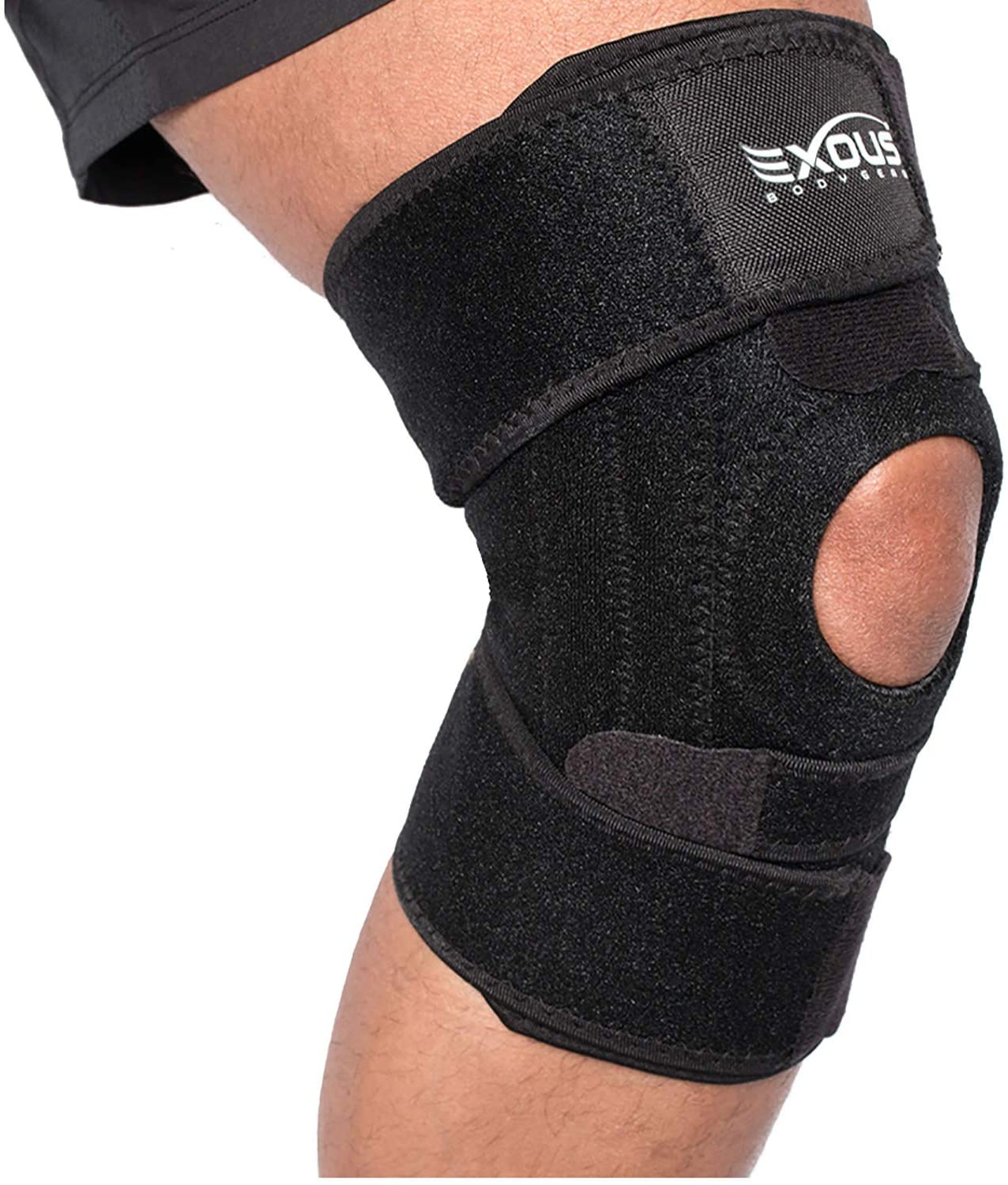
Editor’s Rating:
Design
Unlike the prior knee braces, the EXOUS brace supports the knee exclusively with four compression straps. This design will never be quite as comfortable or unobtrusive as a sleeve brace, but it does more effectively cradle the kneecap while not being so bulky that you’re constantly wanting to take the brace off. The strap-based design also has the added bonus of making the EXOUS Knee Brace Support Protector one-size-fits-all, so you don’t have to worry about purchasing a poorly-fitting brace.
Effectiveness
This brace does an impressive job of fully protecting an injured knee from any further damage. With that added protection do come a few downsides, though. Your range of motion will be slightly restricted, and you won’t forget that it’s there like you might with some of the more comfortable sleeves. Despite that, it’s comfortable and flexible enough that the trade-off should be worth it for most people with moderate to serious knee injuries.
Who Should Buy This Brace?
The EXOUS strap knee brace is well suited for those who do want a comfortable knee brace without a lot of bulk, but need a little bit more protection. Though not quite heavy-duty enough for very serious injuries, it is perfect for anyone looking for a bit more knee cap protection than sleeve braces can provide. This added protection does, unfortunately, come with an added cost—though nowhere near the high end of the market, the EXOUS Knee Brace Support Protector will cost you about twice what you might spend on a high-quality sleeve.
- Four-way compression stabilizes and supports the knee
- Extra attention is paid to protecting the kneecap
- One-size-fits-all
- Somewhat less comfortable than a sleeve-style brace
- About twice as expensive as its comparable alternatives
6. Best Hybrid: Athledict Knee Brace Compression Sleeve
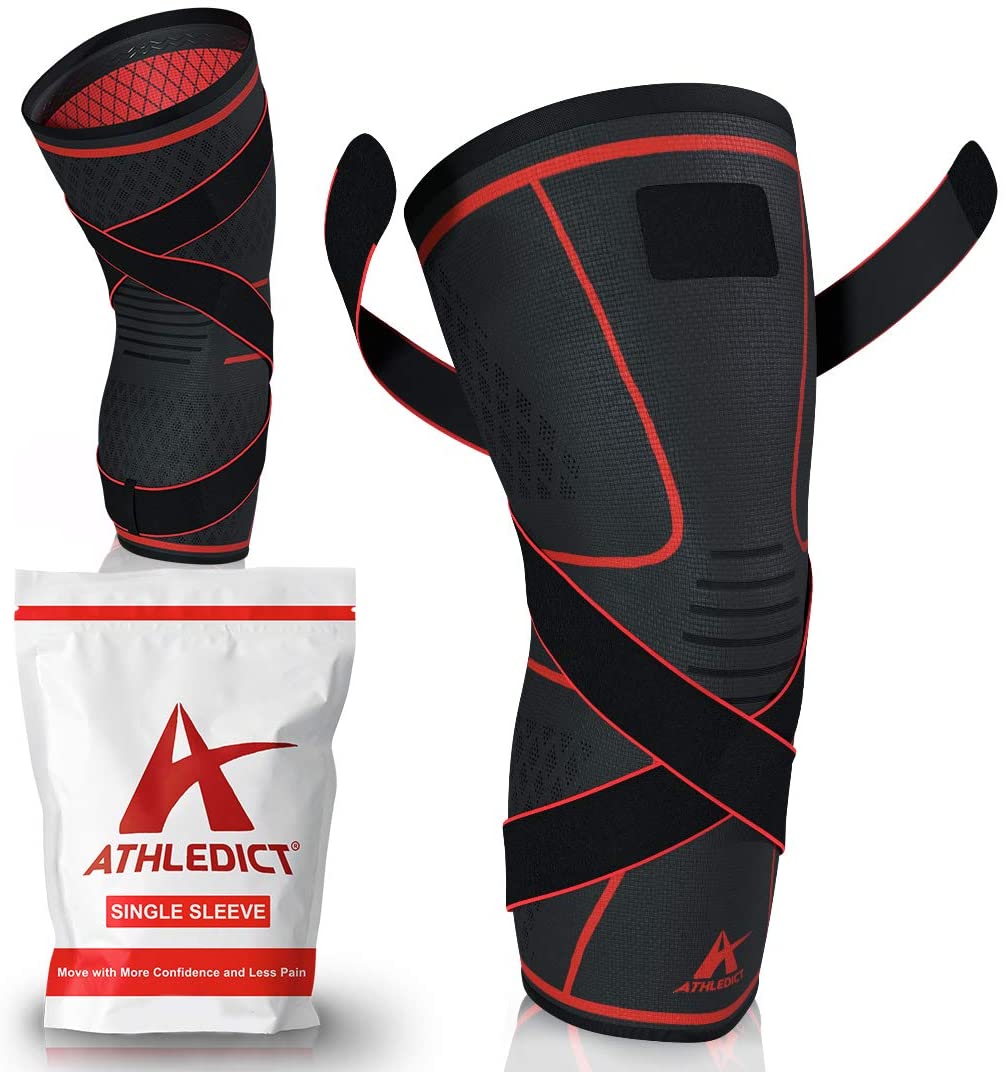
Editor’s Rating:
Design
Most of the compression on the Athledict combination-style brace comes from the anatomically cradling sleeve, but this product’s killer feature is its two Velcro straps. This brace won’t be quite as protective as a brace that exclusively uses straps, but it will be much less bulky and more comfortable. On top of that, the straps can be positioned wherever you like, allowing you to target specific problem areas that require added compression.
Effectiveness
The Athledict Knee Brace Compression sleeve is neither as protective as an all-out wrap-style brace, nor as comfortable as one that is solely a sleeve. On the other hand, this product is more comfortable than a strap-only product and more protective than a sleeve. Whether or not that tradeoff is worth it depends on your specific needs, but in any case, this brace is an attractive middle ground between the two styles.
Who Should Buy This Brace?
If a sleeve brace doesn’t quite provide the protection or compression that you desire, but the bulk of a heavier duty wrap or strap brace bothers you or restricts your range of motion, the Athledict brace should be the perfect middle ground for you. As an added bonus, it comes in a whopping seven sizes—which, when combined with its adjustable straps, makes it potentially the best fitting knee brace for sports on the market.
- Nearly as comfortable as a sleeve-style brace
- Almost as protective as a wrap-style brace
- Comes in seven different sizes and has adjustable straps to ensure a proper fit
- In attempting to combine the protection of a wrap brace and the comfort of a sleeve brace, this hybrid falls a bit short compared to each of its inspirations
7. Best Comfort Option for the Meniscus: TechWare Pro Knee Compression Sleeve
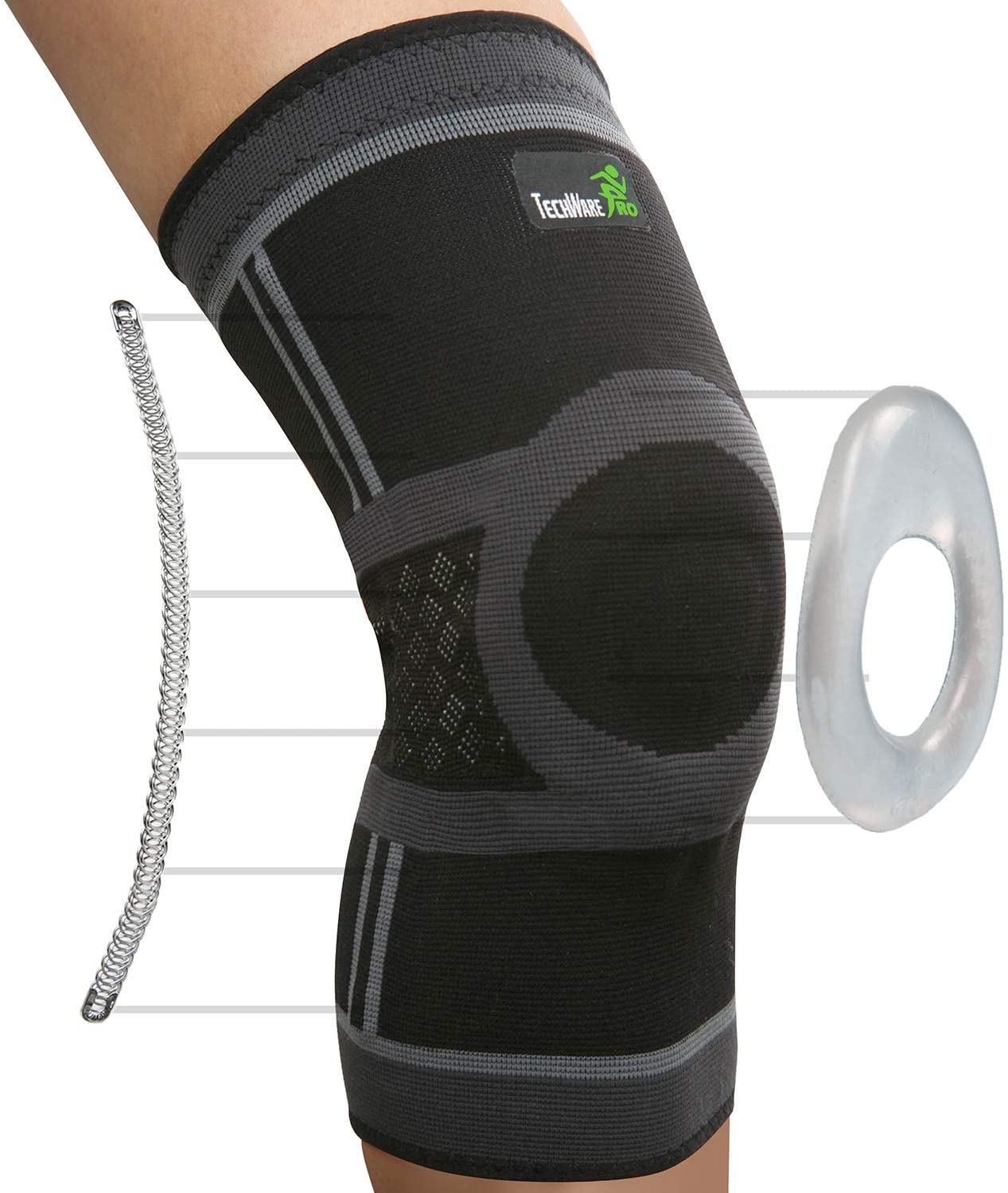
Editor’s Rating:
Design
The TechWare Pro Knee Compression Sleeve is essentially a typical sleeve-style brace with two additional features designed to increase support in the areas needed to protect a damaged meniscus. The first uses two metal stabilizer springs to keep the knee in place, while the second is a patellar gel pad that adds additional compression and support to the kneecap.
Effectiveness
Some knee braces with patellar side stabilizers might be too restrictive, especially for high-performance sport uses, but the TechWare brace hits the balance better than any other brace suited for meniscus problems. The large underlying sleeve does a perfectly good job of compressing the entire region, while the stabilizer springs and gel pad give extra support to the injured problem areas.
Who Should Buy This Brace?
TechWare’s meniscus sleeve provides a moderate amount of support to the knee as a whole, with additional attention being paid to the kneecap, and does so with minimal sacrifices to your range of motion. While there are alternatives that protect the meniscus more fully, as well as more comfortable options, no product hits the sweet spot between these two considerations quite as well.
- Metal side stabilizers prevent reinjuries to the meniscus and encourage faster recovery
- Closed-patella design and gel pad cradle and protect the knee cap, while still allowing it an acceptable range of motion
- Large sleeve compresses and protects the rest of the knee
- Might not be protective enough for the early stages after a serious meniscus injury
8. Best Support Option for the Meniscus: Bodyprox Knee Brace With Side Stabilizers
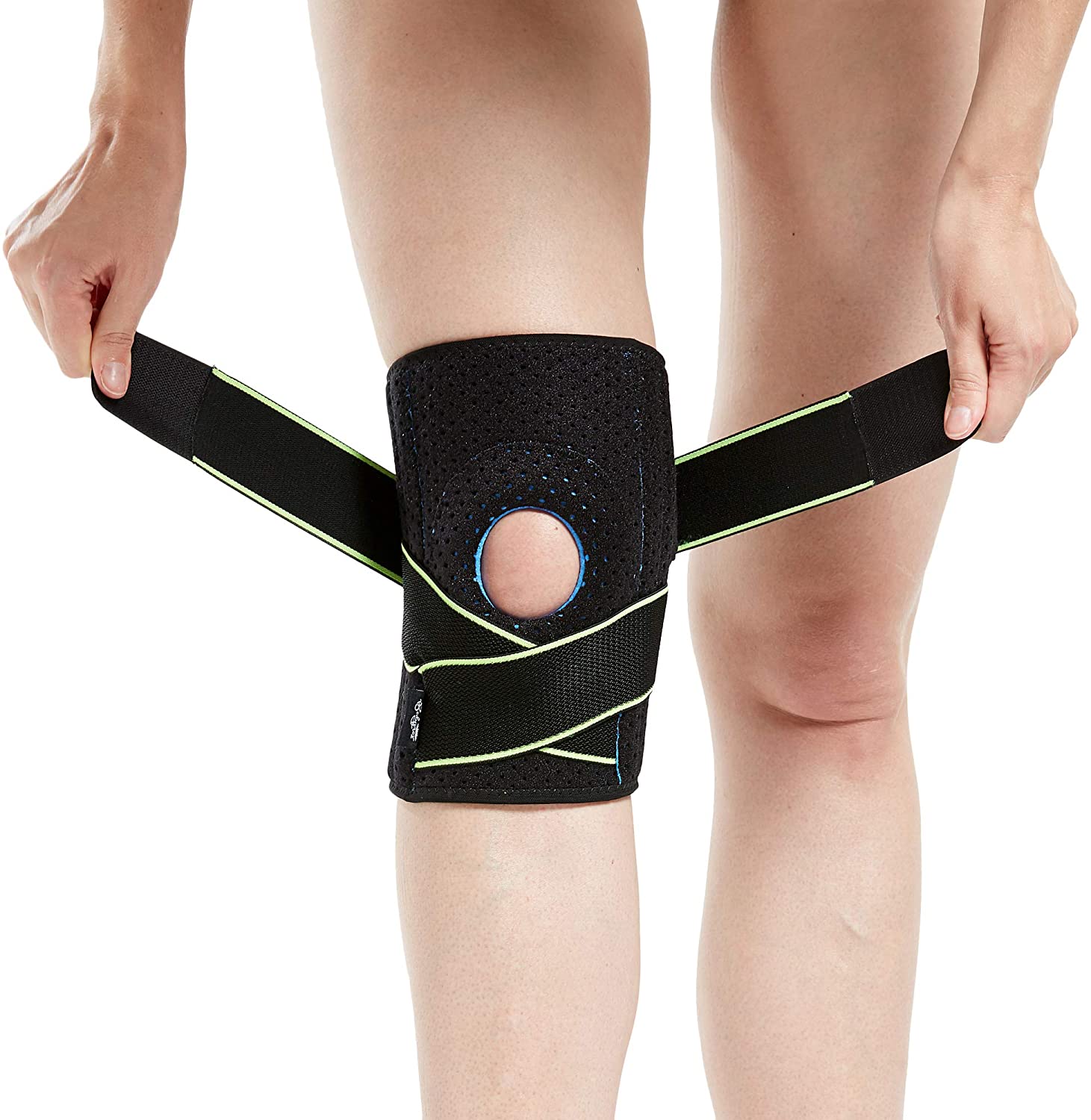
Editor’s Rating:
Design
The Bodyprox Knee Brace with Side Stabilizers uses heavy-duty Velcro straps to provide complete all-around protection, and combines these with side stabilizers to add even more support to the kneecap. In order to balance this strong but restrictive support, it features an open-patella design that allows the kneecap to move relatively freely while still maintaining excellent pressure.
Effectiveness
Though just a little bit less comfortable than the TechWare sleeve-style side stabilizing brace, the Bodyprox is by no means annoying to wear. It won’t fit under clothes quite as neatly, but it makes up for these drawbacks with its excellent protectiveness. And, despite how effectively it stabilizes the knee, it manages to do an impressive job of allowing you to move as freely as possible.
Who Should Buy This Brace?
If you’re just coming off a serious meniscus injury, or if you’re in recovery but hoping to minimize your chances of reaggravation, the Bodyprox Knee Brace with Side Stabilizers is an excellent choice. It might not be as performance-oriented as the TechWare, but its protection and safety-first feature set make it a safer choice, while still allowing for adequate motion.
- Metal stabilizers on both sides provide maximum recovery and protection
- Multiple straps ensure a perfectly supportive and comfortable fit
- Open-patella design with interior gel pad allows the knee cap to have impressive freedom of movement
- Not quite as comfortable or flexible as a non-stabilizing sleeve
9. Best for General ACL Injuries: TechWare Pro Knee Brace
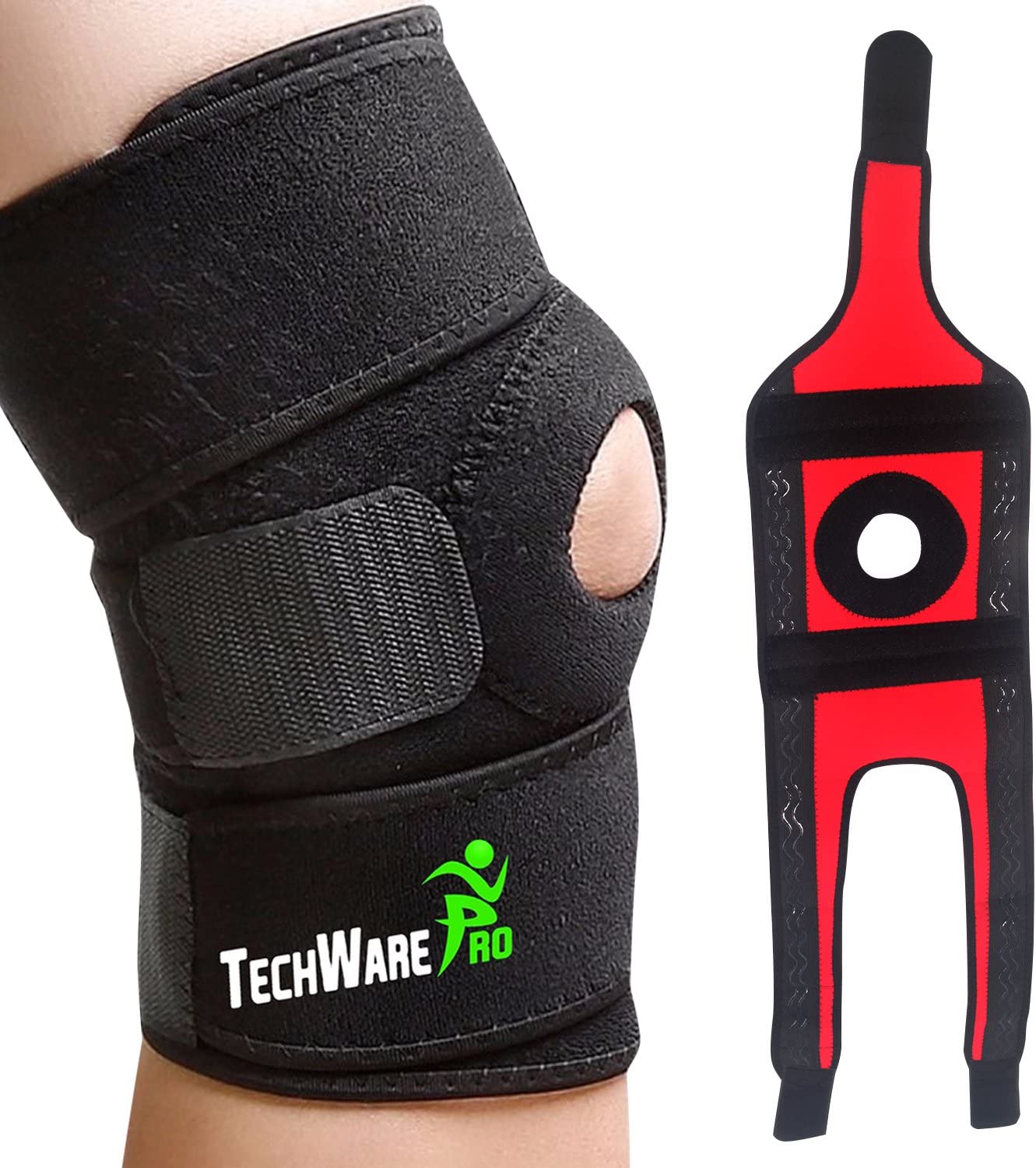
Editor’s Rating:
Design
This brace combines large and powerful straps in its body that stabilize the entire knee with an additional support piece that uses small stabilizer coils and silicone grips to focus on the ACL. This targeted compression allows the product to be effective against mild to moderate ACL damage, while remaining impressively unobtrusive and comfortable.
Effectiveness
The TechWare Pro Knee Brace for ACL problems emphasizes comfort and range of motion over protection, just like TechWare’s meniscus brace. That’s not to say that it’s not protective enough—when used in the right context, this TechWare brace will keep your ACL safe. There are more protective knee braces for sports out there, but there aren’t any that so deftly combine performance considerations with injury prevention and rehabilitation.
Who Should Buy This Brace?
If you’re just coming off a serious meniscus injury, or if you’re in recovery but hoping to minimize your chances of reaggravation, the Bodyprox Knee Brace with Side Stabilizers is an excellent choice. It might not be as performance-oriented as the TechWare, but its protection and safety-first feature set make it a safer choice, while still allowing for adequate motion.
- Much more comfortable and compact than the Shock Doctor
- Adjustable straps contain stabilizer coils to ensure a flexible and supportive fit
- Should stay in place thanks to bi-directional straps and silicone grips
- Alongside the product being less restrictive, it’s also less supportive and protective
10. Best Budget for Late-Stage Recovery: Solimo Elastic Knee Stabilizer
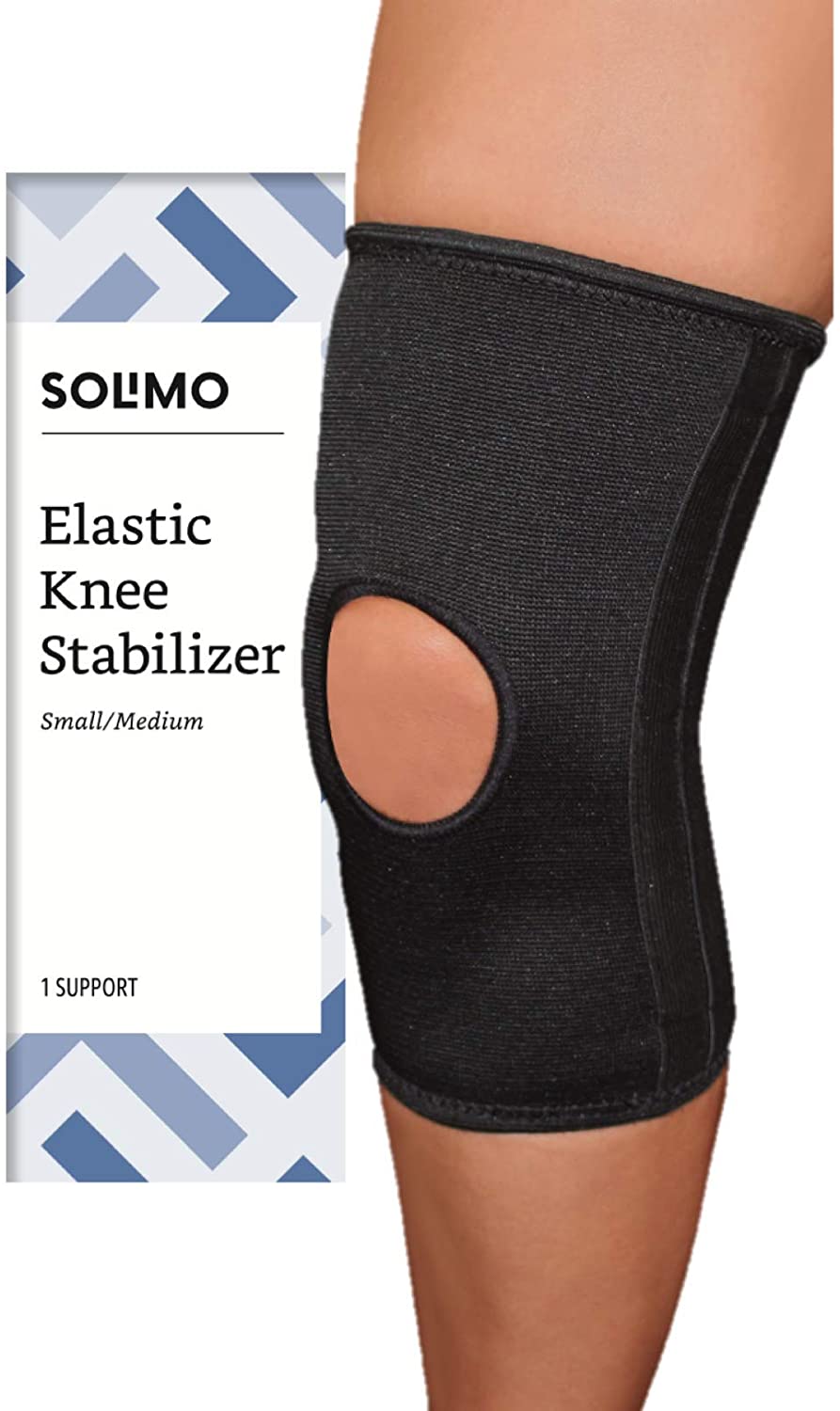
Editor’s Rating:
Design
The Solimo Elastic Knee Stabilizer is entirely different from every other knee brace on this list. It has no fancy features or gimmicks, and it’s so minimalist that it shouldn’t be considered for anything more serious than the last days of recovery from a minor knee injury. Where it stands out is its simplicity and effectiveness for injury prevention, as well as light rehabilitation. The elastic Solimo brace’s lightweight, simple construction combined with a large aperture above the kneecap give it best-in-class freedom of motion and comfort, while still providing enough protection for its intended use.
Effectiveness
This brace isn’t hugely protective, but it’s not meant to be. What you lose in stabilization you gain in comfort and freedom of motion. Despite the product’s very cheap price, no corners were cut in its construction—as long as you’re purchasing the brace for the correct purpose, you won’t be disappointed in its quality. The lone flaw in the Solimo brace is that there are only two sizing options. While it’s stretchy enough that this won’t prevent the brace from doing its job, it might be slightly uncomfortable if you’re on the edge of either size.
Who Should Buy This Brace?
The Solimo Elastic Knee Stabilizer is the least protective brace on this list, but that’s not necessarily a bad thing. Different knee braces are suited for different purposes, and this brace does what it is intended to do perfectly. If you’re just coming off a serious knee injury, this is not the product for you, but if you’re in the late stages of recovery or just looking for a little added support and durability, the Solimo brace is exactly what you need.
- Bargain-basement price with incredible value for your money
- Simple, no-frills construction
- Only minimally protective
- Limited sizing options might result in an uncomfortable fit
Guide to Buying the Best Knee Braces for Sports
Although some knee braces are one-size-fits-all in a literal sense, the same is not true of their ideal use cases. A few common types of knee problems dominate the market for braces, but even among them, braces can be designed with either rehabilitation or prevention in mind. Matching the brace not only to the type of injury but also to its severity is essential for selecting the proper product. On top of that, there are several different styles of braces designed to tackle each type of problem, with prices ranging from just a few dollars to a few hundred.
Before you rush into purchasing a brace, be sure that it’s going to fit perfectly. A good fit should be snug and tight, but not so restrictive that it hurts or cuts off your circulation. Most knee braces for sports come in a variety of sizes, typically based on a measurement of the circumference of your leg about six inches above the knee cap—but this varies by manufacturer, so make sure you do your research before purchasing. Some elastic and silicone braces do come in a one-size-fits-all style, but these might be uncomfortably tight for larger people or too loose for people who are smaller than average, so proceed with caution.
Intended Use
By wearing a knee brace designed for your specific needs and following a rehabilitation exercise program, you can not only reduce the pain caused by your injury but significantly speed up recovery. Wearing the incorrect type of knee brace, on the other hand, will cause discomfort and needless complications, and may not help to protect you at all.
General Rehabilitation, Prevention, and Minor Injuries
If you haven’t undergone a serious knee injury, or if your injury has healed to the extent that you’re willing to sacrifice some amount of protection for mobility, you’ll likely want to purchase a knee brace that is designed either for general rehabilitation and prevention or for recovery from relatively minor injuries like sprains and mild hyperextension. The best types of knee braces for these ailments generally tend to be sleeves, but often incorporate small wraps or straps.
Meniscus Tears
For more serious injuries like a torn meniscus, you’ll be in the market for a totally different style of knee brace. When your injury is localized within this area, you’ll need something to immobilize and keep pressure on the knee cap. Knee braces for this type of injury tend to use wraps, straps, or hinges, but are often most effective when they combine with comfort of sleeve braces with flexible metal patellar supports on the side of the knee cap.
Anterior Cruciate Ligament (ACL) Tears and Sprains
The same is true for deep ligament injuries, like ACL tears or sprains. It’s not enough to find the most popular or most expensive knee brace for sports and blindly purchase it—there are specific considerations that must be taken into account for ACL injuries, too. Here, the risk of reaggravating an injury is often too great to value considerations like comfort and range of motion over stabilization and protection. As the recovery process continues you might consider switching to a general rehab brace, but in the early days and weeks after an ACL injury you’ll likely want a thick, restrictive, pressuring heavy-duty strap brace.
Styles
Another important consideration with knee braces is which of the many types of braces is right for you. This will not only be related to the issue that you’re trying to resolve with the brace, but also comfort and personal preference.
Even among the same style of knee braces, there are variations in materials. These different materials in turn have different effects on your knees. By and large, knee brace materials can be separated into two categories: soft and rigid. These categories are not absolute or exclusive, and many braces sit at a mid-way point on this continuum, but that does not make it any less important of a factor to consider. Additionally, different methods of bracing the knee—sleeves, wraps, straps, and hinges—each come with their pros and cons, and are often combined within a single product.
Sleeve Braces
Soft sleeve-style knee braces tend to be thin, unobtrusive, breathable, and comfortable, but often sacrifice protectiveness to gain these qualities. These types of braces are stylish and allow for comfortable movement that doesn’t sacrifice performance. That being said, due to the fact that they don’t offer the same protection, it’s not best to use these for anything but the later stages of recovery.
Wrap and Strap Braces
Braces that are secured to the knee with wraps or straps fill a void between the comfort of sleeves and the protection of hinged braces. They use small but powerful supports to provide a gentler (but still protective) pressure to the knee than hinges, while still retaining a relatively low profile like sleeve braces. These can be preferable when you’re nursing an injury but still required to perform at a high level, as well as for recovering from moderate injuries that don’t quite necessitate a massive brace.
Hinged Braces
Hinged braces are thicker, bulkier, and less comfortable than both sleeve and wrap or strap braces, but what they lack in these areas they make up for by providing maximum support to the knee. These won’t look nearly as nice under your clothes, and you won’t ever forget that you’re wearing a hinged brace like you might a well-fitting sleeve, but they’re often preferable in the case of serious injuries. Even for less drastic damage, they can be useful in the early days of an injury when performance concerns should be subservient to preventing further injury.
Patellar Protection
A second common differentiator within brace styles is if the brace has a closed or open patellar area (the area of the brace above the knee cap). Any of the above types of products can be made with an open- or closed-patella design. An open-patella brace allows the knee cap room to move unimpeded, which reduces restrictions on mobility and may prevent pain, while a closed-patella brace compresses and stabilizes the knee cap, providing added support and decreasing the chances of the knee-cap being subject to any further injury.
Supports
Some knee braces contain thin metal coils on either or both sides of the knee which are designed to provide additional strength and structure. These are very useful in reducing pain and the chance of reinjury. They should be used whenever you have significant pain on or around the knee cap, which is often caused by tearing or otherwise damaging the meniscus of the knee.
Final Thoughts
In an ideal world, you could consider solely the above criteria when deciding which knee brace to purchase. Unfortunately, most people are working within spending limits, and the price ceiling on some braces is quite high. Those with an unlimited budget or anyone who relies on their knees to earn a living could easily be tempted to spend lavishly on an excellent product—but doing so isn’t at all essential to purchasing the best knee brace for sports.
Some of the top-of-the-line knee braces on the market cost several hundred dollars—or more, if you spring for a custom fit. Still, those who can’t afford to splurge but still want to find an effective brace won’t be left out, despite the overly expensive options out there. There is very little to be gained in quality by spending over a hundred dollars on a heavy-duty hinged knee brace or more than thirty dollars on a comfortable and protective sleeve brace, unless you’re recommended a specific model by your doctor. For everyone else, one of the products on this list should meet your needs perfectly.
